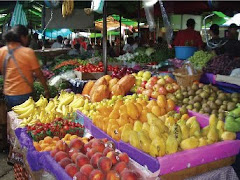

We anchored off Roman's resort and dingied into town. We quickly realized that everyone in San Pedro is in a hurry, and everything in San Pedro is expensive. The major modes of transportation are small automobiles, golf carts and bicycles with the occasional tractor (as in John Deere) with a small trailer attached, which is used to deliver beer and bottled water to the local stores, bars and restaurants. Walking the streets with all this traffic is harrowing at times. Bill found parts for his fishing rods at a small tackle shop called Fins and Feathers, which was operated by an expat from Houston Texas. We quickly found that groceries were two to three times the cost we were used to paying in Mexico.
One bright spot was the Customs and Immigrations office. They were efficient and pleasant. Immigrations now charges a fee of $20.00 US, and Customs also charges a fee of $20.00 US, plus a fee of $25.00 US each time you renew your 30 day permit. I'm not sure what the exit fee is, but I know there is one. We were required to dingy the Customs' guy out to our boat and let him inspect it. He stated that they were most interested in firearms, and since we didn't have any, we passed inspection with flying colors. As we began our dingy ride back to the dock, the Customs guy noticed another new boat in the anchorage flying the yellow quarantine flag, so I dropped him off at that boat, and they agreed to take him back to land after he inspected their boat. What else could they do?
The next morning, we weighed anchor and moved down to the little town of Cay Caulker. What a difference eight miles makes. Everything is still expensive, but no one seems to be in a hurry. The town seems to be a cross between a fishing village and a tourist town. No streets are paved here. They are white sand and the only automobile we have seen is the local government's old dump truck which they seem to use for everthing from garbage pickup to mass transit. Everyone else uses bicycles, golf carts or simply walks to where they are going.There are tourists from all over the world here. We have heard people speaking French, German, English, Spanish and other languages which we didn't even recognize. There are lots of restaurants and bars, a couple of grocery stores, several dive shops offering snorkel and dive trips, and the usual gift shops and mom and pop resorts. And they have a great bakery and homemade ice cream to die for! A nice little town, we like it here!






Another norther was predicted, so we made the trip down to the Drowned Cays, about 15 miles south of Cay Caulker and only about 5 miles east of Belize City. To get there you had to go through the dreaded Porto Stuck channel, which is less than 5 feet deep at low tide. We had no problem with the channel, however there were a couple of times that we only had a couple of inches between the keel and the bottom. The Drowned Cays are unpopulated Mangrove islands with several wide and protected creeks--a good place to be with strong north winds. We spent two days there doing absolutely nothing before heading back up to Caye Caulker, where we will probably spend much of our time until we pick up guests at Cucumber Beach Marina in Belize City on the 20th of February.


